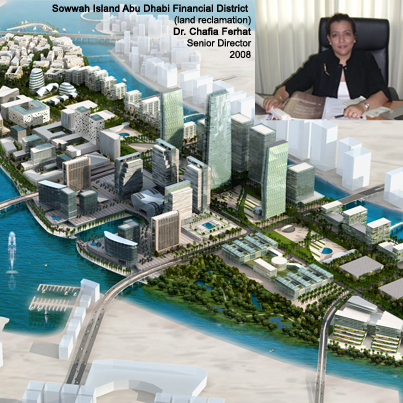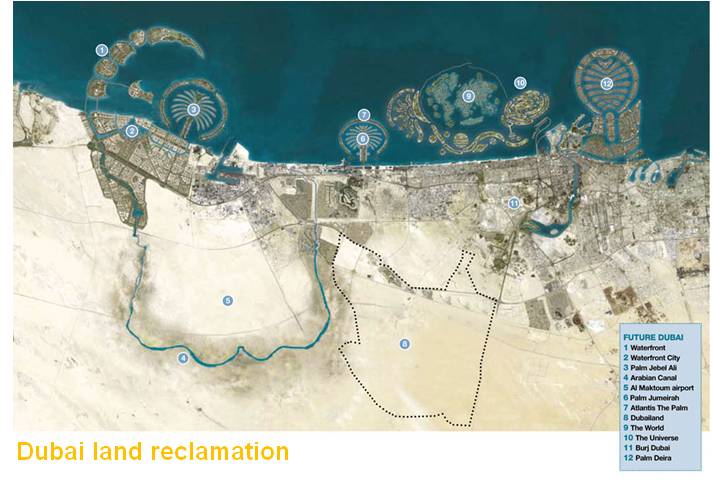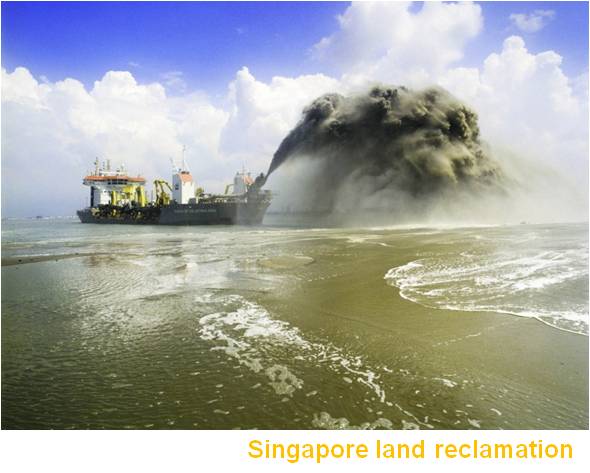WaterWorld
- Dr. Chafia Ferhat
- October 15, 2013
- Sustainability
- architecture, Building, buildings and developments, Chafia Ferhat, Design and Innovation, DESIGNERS, Dr. Chafia Ferhat, environment, FENN DESIGNERS, Land Reclamation, Rising Sea Levels, Singapore, Sinking Cities, Sustainable, Waterfront Development
- 0 Comments
For Centuries human settlements developed and expanded near waterfronts. When roads were primitive, rivers were the highways for people and goods transportation. No wonder most of the world greatest cities are built along major rivers and seashores. Bangkok, London, Paris, Venice, like many others waterfront cities have developed over the centuries to become major metropolitan thanks to their access to waterways. The waterfront element offered ample opportunities for trade, business and recreation.
These days however, countries are racing to extend their waterfront sides not for transportation purposes but to extend their land mass and increase waterfront property land which sells for a lot higher price than inland properties. Dubai, Singapore, Hong Kong, Taiwan are few among many cities that have undertaken considerable land reclamations. Land reclamation has also played a significant role in the urban development process in the coastal areas of many maritime countries. Countries reclaimed their coastal area to solve their problem of land-shortage; the land is limited while the number of population increased continuously.
The questions are; firstly given all the concerns over global warming and the rising sea levels, are these reclamations sensible and secondly what are the environmental impacts these extra land masses have on the marine life and on nature in general? Let’s look at some very pertinent examples:
The Palm Island and the World Dubai, two projects of great magnitude they have reshaped Dubai, The land reclamation however wasn’t done for land shortage reasons but for creating more seafront properties. What are experts point of views on that;
“significant changes in the maritime environment [of Dubai] are leaving a visual scar [. . .] As a result of the dredging and re-depositing of sand for the construction of the islands, the typically crystalline waters of the gulf of Dubai have become severely clouded with silt. Construction activity is damaging the marine habitat, burying coral reefs, oyster beds and subterranean fields of sea grass, threatening local marine species as well as other species dependent on them for food. Oyster beds have been covered in as much as two inches of sediment, while above the water, beaches are eroding with the disruption of natural currents” (“Dubai’s artificial islands have high environmental cost”). Mongabay.com, a site dedicated to rain forest conservation
Singapore ever increasing land mass
The densely populated state of Singapore has expanded in size by more than 20 per cent since 1960 by reclaiming huge area of land from the sea. For that they need a LOT of sand, this sand is all imported from poor South East Asian like Cambodia, 796,000 tonnes of sand are still being extracted and exported to Singapore every year from just one province, Koh Kong.
According to the ecologist.org “The extraction is coming at a significant environmental cost. Dredging reduces water quality by increasing turbidity, blocking sunlight and killing off plant life, including sea grass and coral. Sand extraction also disrupts natural sedimentary regimes causing increased erosion and greater flood risks. There have also been reports of significant declines in fish stocks.”
Land reclamation is very popular in Asia because of its growing urban population but it all comes at a great cost. It is happening in Hong Kong, Japan, Taiwan, China and to a very large scale in South Korea who is undertaking the world largest reclamation at 40,100 hectares in Saemankeum!
Despite the major outcry from ecologists and environmentalists, and the major natural disasters we are seeing these days on waterfronts, land reclamation is anything but slowing down. It is in fact accelerating not only to satisfy the ever increasing thirst for land for some, but for completely outrageous reasons for others!
Related Posts
- Tarkoon Suwansukhum
- September 5, 2013
How to Design Car Parking for Low-Rise Buildings
ผมเป็นคนหนึ่งที่ต้องใช้รถยนต์ใน ..
- Sheetal Chailertborisuth
- September 2, 2013
Recycled Tires=ART
In my last articles, I have written about simple objects we use at home that accumulate in ..


